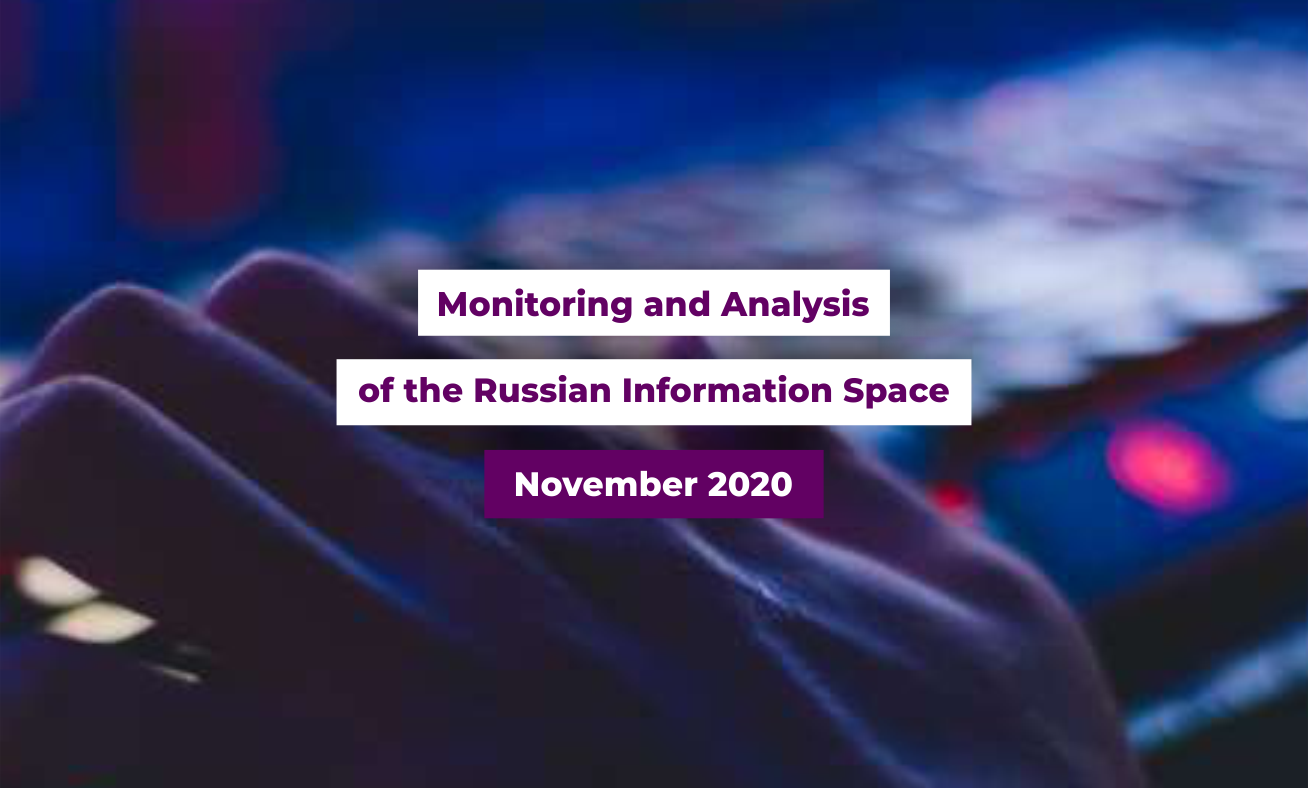Monitoring and analysis of the Russian information space: November 2020

Monitoring and analysis of the Russian information space as exemplified by the articles published by ria.ru, rbr.ru and russian.rt.com between 2-29 November 2020.
Below are presented the partial results of the monitoring conducted by the Center for Propaganda and Disinformation Analysis as a part of the “Monitoring and analysis of the Russian information space” project and implemented during the period of 3 August 2020 to 28 February 2021.
 Source: Own elaboration, Center for Propaganda and Disinformation Analysis
Source: Own elaboration, Center for Propaganda and Disinformation Analysis
Quantitative analysis:
Monitored media outlets: ria.ru, rbc.ru, russian.rt.com
Subject area: Poland, European Union, United Kingdom, Baltic states (Lithuania, Latvia, Estonia)
Time frame: 2-29 November 2020
Total number of news published on ria.ru, rbr.ru and russian.rt.com: 31671, namely 23088 news from ria.ru (from 5656 to 5849 news per week), 3196 news from rbr.ru (from 743 to 866 news per week) and 5387 news from russian.rt.com (from 1317 to 1367 news per week). There was a decrease in total number of published news compared to October 2020.
Total number of news about Poland, the European Union, the United Kingdom and Baltic states (Lithuania, Latvia, Estonia) in the monitored media: 1026, namely 536 news from ria.ru, 242 news from rbc.ru and 248 news from russian.rt.com. The news about Poland, the EU, the UK and Baltic states accounted for 2,3% of all the news published on ria.ru, 7,6% on rbc.ru and 4,6% – on russian.rt.com. This news together accounted for 3,2% of all the news published in the monitored websites in November 2020. There was a decrease in total number of news on monitored topics, both in terms of numbers and percentage shares of all the published news compared to the previous month. November 2020 saw the lowest total number of published news about Poland, the European Union, the United Kingdom and Baltic states (Lithuania, Latvia and Estonia) in the monitored media.
Total number of the monitored news: 1026, including 343 news on the European Union (which accounts for 1,1% of all the news published in the monitored media in November 2020), 323 news on the United Kingdom (1,0%), 217 news on Poland (0,7%) and 144 news on Baltic states (Lithuania, Latvia, Estonia) (0,5%).

Source: Own elaboration, Center for Propaganda and Disinformation Analysis
Qualitative analysis:
Along with the beginning of the spread of coronavirus in the world, a growing Russian disinformation and propaganda regarding this topic could be observed. Disinformation in the Russian information space was mainly related to the origin of coronavirus, effectiveness of vaccines from various countries, methods of treatment of the disease or self-diagnosis. Blatant misinformation of the society was aimed at leading to a decline in citizens' trust towards the government of the country concerned, which as a result was supposed to intensify the sense of danger.
In order to strengthen the lack of public trust, Russian media was also spreading numerous conspiracy theories on vaccines. According to one of them, the role of a vaccine boiled down to strengthening control over society through, among others, using microchipping, and even reducing the world's population by introducing mass vaccinations.
On the other hand, narratives about the coronavirus vaccine registered in Russia were appearing most often in the context of promoting this drug substance as a cure-all and undermining the Western countries.
We identified a consistently conducted disinformation campaign with regard to the strong interest in Sputnik V in the world, indicating potential recipients in the countries of Latin America, the former USSR, the Middle East and Asia, Central and Eastern Europe, or non-EU part of the Balkans.
One of the examples of such campaign was the attempt to discredit the Western pharmaceutical companies. A narrative appeared in the Russian media, according to which the Russian Sputnik V vaccine was the most effective one against COVID-19 in the world, making Russia a leader in this area. Along with that, Russian media was spreading a theory that criticism towards their vaccine in the Western states was based solely on political and economic reasons, and not scientific ones.
The monitoring and analysis was conducted by: Adam Błonowski, Bartosz Gralicki
Project coordinator and editorial supervision: Marta Kowalska
Graphic layout and editorial supervision: Katarzyna Rogala
READ THE FULL REPORT: This article is part of the “Monitoring and analysis of the Russian information space: the image of Poland, NATO, European Union, United Kingdom, Baltic states and Belarus in the Russian online media outlets”.
See related:
- Monitoring and analysis of the Russian information space between 3 and 30 August 2020
- Monitoring and analysis of the Russian information space between 31 August and 27 September 2020
- Monitoring and analysis of the Russian information space between 28 September and 1 November 2020
- Monitoring and analysis of the Russian information space between 30 November 2020 and 3 January 2021
- Monitoring and analysis of the Russian information space between 4-31 January 2021
- Monitoring and analysis of the Russian information space between 1-21 February 2021
- Monitoring and analysis of the Russian information space between 31 August 2020 and 14 February 2021
The publication is part of the report: “Monitoring and analysis of the Russian information space”. The project was carried out in cooperation of the Center for Propaganda and Disinformation Analysis (CAPD) and Open Information Partnership (OIP). The publication solely reflects the authors’ opinions and should not be equated with the official position of the Open Information Partnership. The publication serves as contribution to the public debate.

